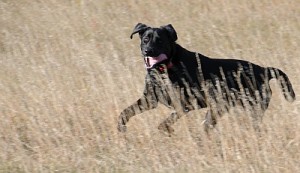 Last fall I had a real eye opener. We were hunting a field for pheasants in northern Montana – a field that we have hunted several times in the past. The day was windy and hot and the cover was very thick. My dog Radar, a 75lb black lab, had a big drink before we started the field. The pheasants were running and my dog was working hard to push them up. The first shot at a rooster winged it, sending Radar on a long 300-400 yard chase. After he retrieved the bird I offered him water, but he refused, ready to go after the next bird. Sometimes Radar gets in ‘the zone’ while hunting, blocking everything else out. Such was the case that day. Focused on pheasants, he refused water time and again (“Training Your Hunting Dog to Drink” – Quail Forever)
Last fall I had a real eye opener. We were hunting a field for pheasants in northern Montana – a field that we have hunted several times in the past. The day was windy and hot and the cover was very thick. My dog Radar, a 75lb black lab, had a big drink before we started the field. The pheasants were running and my dog was working hard to push them up. The first shot at a rooster winged it, sending Radar on a long 300-400 yard chase. After he retrieved the bird I offered him water, but he refused, ready to go after the next bird. Sometimes Radar gets in ‘the zone’ while hunting, blocking everything else out. Such was the case that day. Focused on pheasants, he refused water time and again (“Training Your Hunting Dog to Drink” – Quail Forever)
Things started to get worse. Radar was panting heavily, his mouth was frothy, and his eyes were glassy. I could see that he was no longer ‘hunting’ only walking forward aimlessly. I realized that I needed to get him cooled down fast. I poured the last of my drinking water over his head and ears. Unfortunately the usual nearby waterholes that he could swim in were dry. We made a bee-line for the truck where I had more water. I got him into the shade and he finally drank! I poured more water on his belly and head to cool him down. The breeze, although hot, was very welcome at this point as it helped speed evaporation and cooling. Resting in the shade, his panting slowed and he appeared to be feeling much better a couple of hours later. I monitored him closely for the last 2 days of our hunt, and only worked him for short periods of time. It became obvious that he had severely overheated and his energy didn’t fully return until a couple of days of rest at home.
Afterwards, I wanted to know more and looked for information about heat exhaustion in dogs – particularly of the hunting variety. What I found alarmed me.
Though not well documented, it is estimated that hundreds of hunting dogs experience heat exhaustion and many die from the more advanced symptoms of heat stroke. Many of the things you can do to prevent it are common sense. Mostly, it is important to monitor your dog for the symptoms of heat exhaustion and treat them early so they do not end up in heat stroke!
Check out the following link for advice about training your dog during the summer or hunting in the heat of the early fall.
“Summer Training: Avoid Heat Stroke” – Ducks Unlimited
Good luck this fall and take good care of your hunting buddy!

Very interesting article, Lowell. I don’t have a dog currently, but would love to hunt with one some day. I hunt mostly desert environments where overheating is a real risk (for humans and dogs!) and it’s never crossed my mind that a dog could refuse water and rest because he’s too focused on the birds. Good to keep in mind. I’m glad your pup was all right in the end!
Thanks Robyn! There is something very special about working with a hunting dog in the field – a partnership like no other! Take care of them and in return they will give it all they’ve got in the field. Plus they make pretty darn good family members too!
Hello,
I love your story, and I am glad that Radar recovered well. Many times we don’t think about thinks like “heat exhaustion and heat stroke” in dogs. Offering water is a great way to prevent dehydration which leads to heat exhaustion, but what if they wont take water? Sometimes precooling can be a beneficial process for animals facing hot weather. Either a swim or laying on a cool mat to get their bellies cooled down. Taking time to cool them before and in between exercise can help prevent heat exhaustion.
Great tips Jill! I know a good swim helps me run a lot cooler in hot weather – ‘precooling’ animals with a swim goes a long way to keeping them healthy and happy in hot weather.
Thankfully I don’t have to worry about that too much in February in Saskatchewan 😉 However, summer and fall are just around the corner. Keep cool out there.